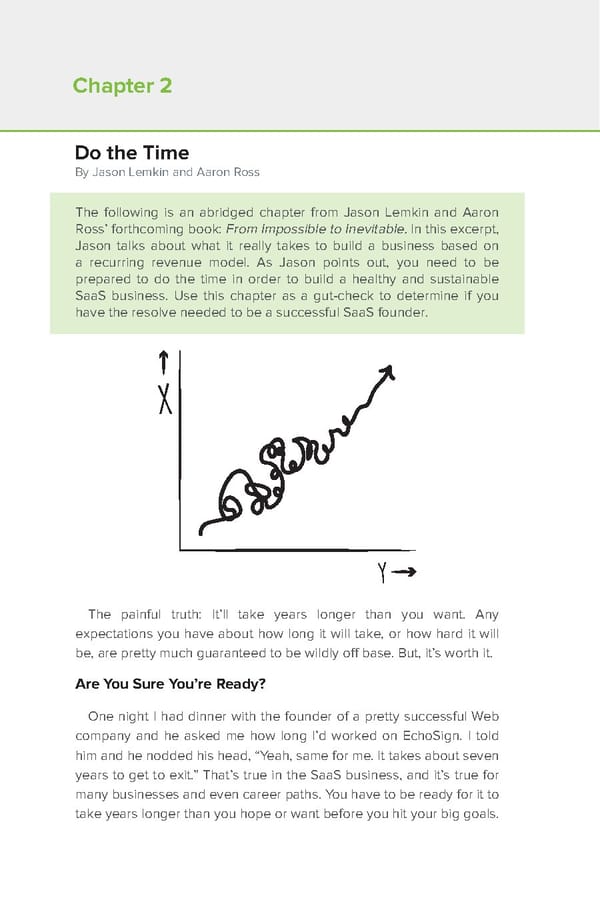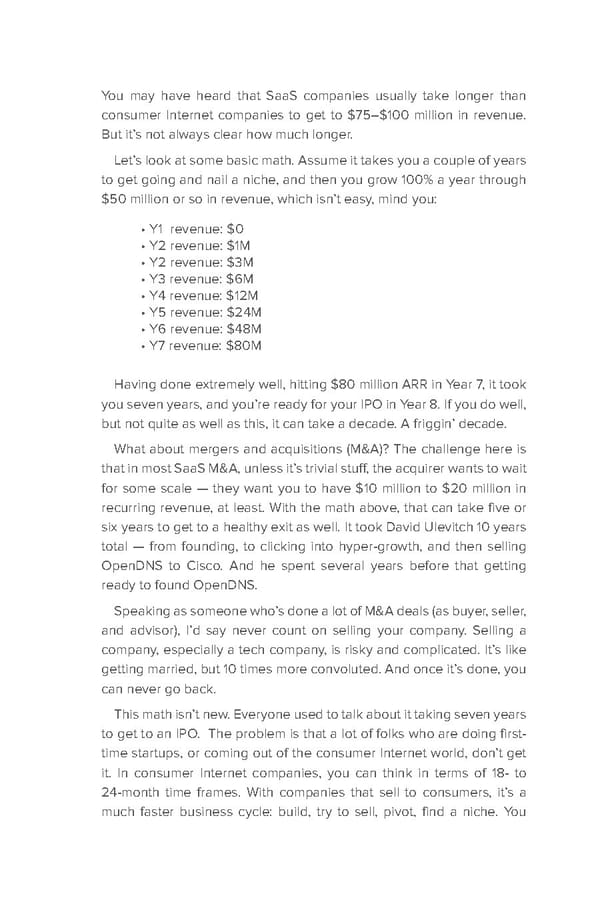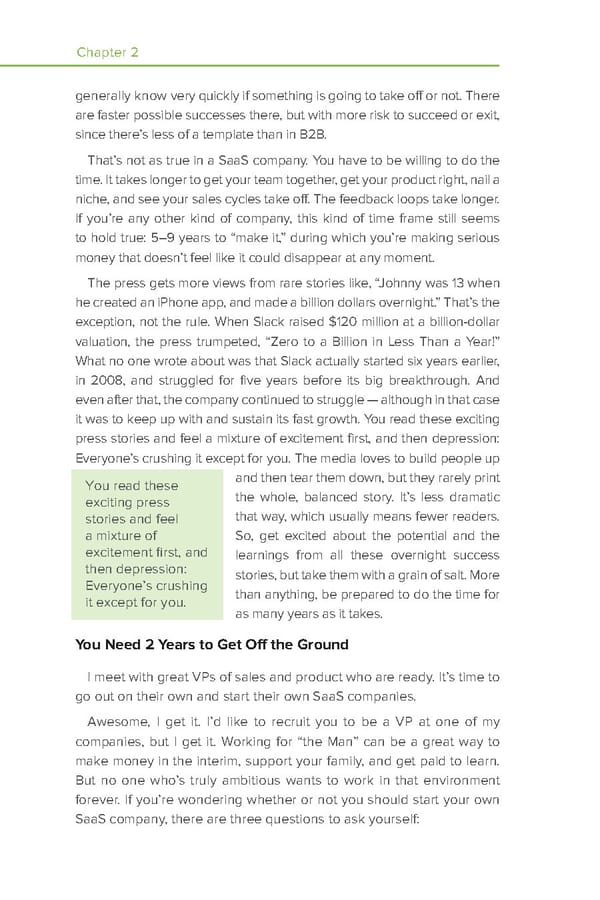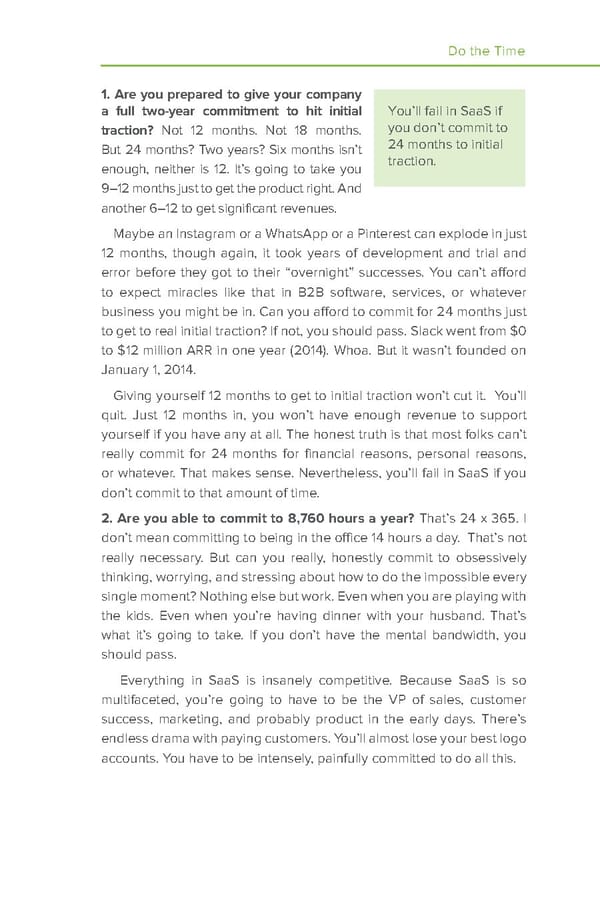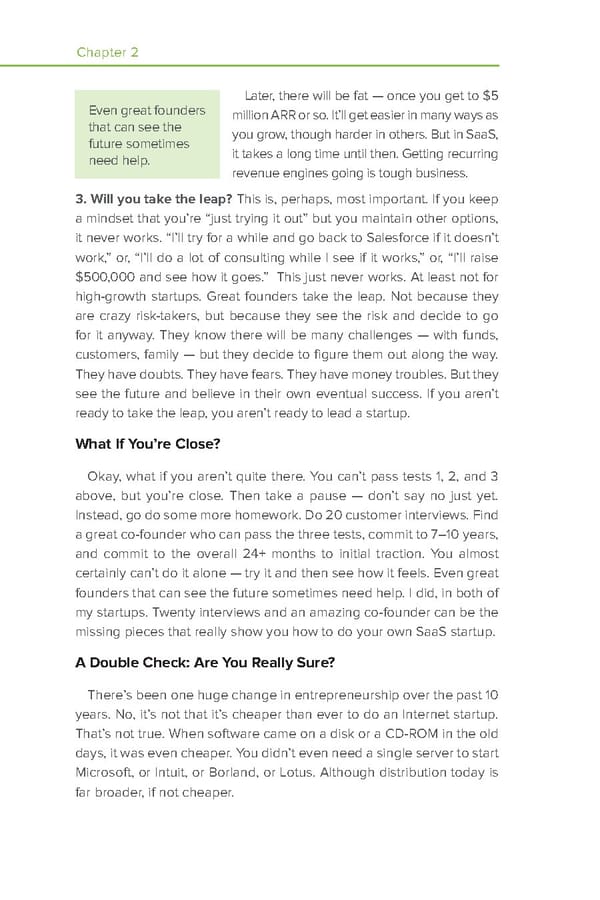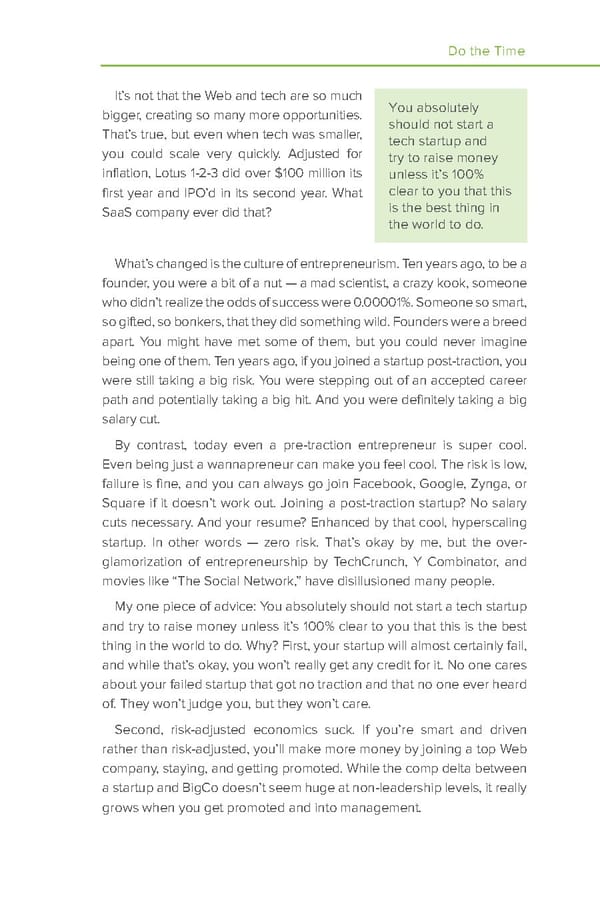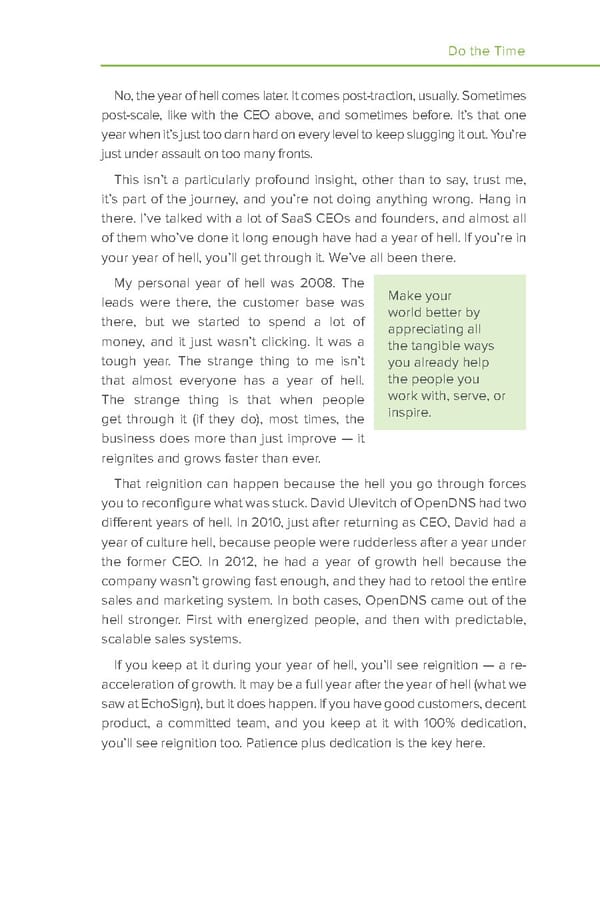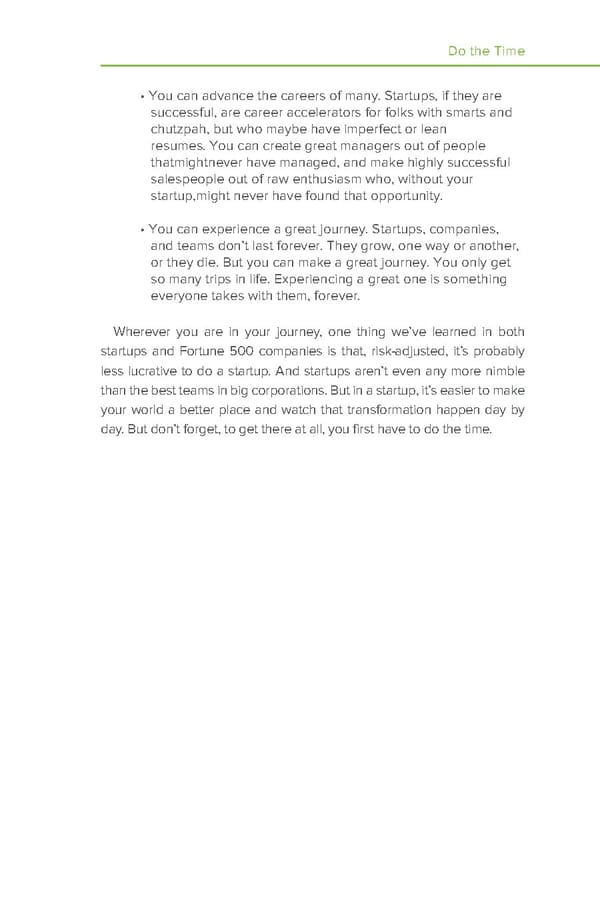Do the Time
By Jason Lemkin, Founder, SaaStr and Aaron Ross, Author, Predictable Revenue
The SaaS Startup Founder’s Guide Concepts, Strategies, and Tactics from SaaS Leaders Table of Contents Introduction 7 Chapter 7 67 Sales Distribution & Segmentation Strategies - By Mike Wolff Chapter 1 10 Chapter 8 74 Subscription Economics: How Customer Experience and Success: Recurring Revenue Changes Both Science and Art Everything - By Tien Tzuo - By Melinda Gonzalez Chapter 2 24 Chapter 9 88 Do the Time CRM and Content: Two Ingredients - By Jason Lemkin and Aaron Ross for Early Startup Success - By Greg Poirier Chapter 3 34 Chapter 10 93 The Climb: How to Get to $10 Filling the Funnel with Content Million Marketing - By Tien Tzuo - By Amanda Nelson Chapter 4 38 Chapter 11 101 Are You a Nice-to-Have? Tools of the Trade - By Jason Lemkin and Aaron Ross - By Greg Poi Chapter 5 43 Contributing Authors 108 Nailing Your Go-to-Market Positioning - By Judy Loehr Chapter 6 56 About Salesforce for 113 Grow Revenue Faster with Startups Messaging Alignment, Playbooks and Onboarding - By Elay Cohen
Chapter 1 Chapter 2 Do the Time By Jason Lemkin and Aaron Ross The following is an abridged chapter from Jason Lemkin and Aaron Ross’ forthcoming book: From Impossible to Inevitable. In this excerpt, Jason talks about what it really takes to build a business based on a recurring revenue model. As Jason points out, you need to be prepared to do the time in order to build a healthy and sustainable SaaS business. Use this chapter as a gut-check to determine if you have the resolve needed to be a successful SaaS founder. x Y The painful truth: It’ll take years longer than you want. Any expectations you have about how long it will take, or how hard it will be, are pretty much guaranteed to be wildly off base. But, it’s worth it. Are You Sure You’re Ready? One night I had dinner with the founder of a pretty successful Web company and he asked me how long I’d worked on EchoSign. I told him and he nodded his head, “Yeah, same for me. It takes about seven years to get to exit.” That’s true in the SaaS business, and it’s true for many businesses and even career paths. You have to be ready for it to take years longer than you hope or want before you hit your big goals.
Chapter 1 You may have heard that SaaS companies usually take longer than consumer Internet companies to get to $75–$100 million in revenue. But it’s not always clear how much longer. Let’s look at some basic math. Assume it takes you a couple of years to get going and nail a niche, and then you grow 100% a year through $50 million or so in revenue, which isn’t easy, mind you: • Y1 revenue: $0 • Y2 revenue: $1M • Y2 revenue: $3M • Y3 revenue: $6M • Y4 revenue: $12M • Y5 revenue: $24M • Y6 revenue: $48M • Y7 revenue: $80M Having done extremely well, hitting $80 million ARR in Year 7, it took you seven years, and you’re ready for your IPO in Year 8. If you do well, but not quite as well as this, it can take a decade. A friggin’ decade. What about mergers and acquisitions (M&A)? The challenge here is that in most SaaS M&A, unless it’s trivial stuff, the acquirer wants to wait for some scale — they want you to have $10 million to $20 million in recurring revenue, at least. With the math above, that can take five or six years to get to a healthy exit as well. It took David Ulevitch 10 years total — from founding, to clicking into hyper-growth, and then selling OpenDNS to Cisco. And he spent several years before that getting ready to found OpenDNS. Speaking as someone who’s done a lot of M&A deals (as buyer, seller, and advisor), I’d say never count on selling your company. Selling a company, especially a tech company, is risky and complicated. It’s like getting married, but 10 times more convoluted. And once it’s done, you can never go back. This math isn’t new. Everyone used to talk about it taking seven years to get to an IPO. The problem is that a lot of folks who are doing first- time startups, or coming out of the consumer Internet world, don’t get it. In consumer Internet companies, you can think in terms of 18- to 24-month time frames. With companies that sell to consumers, it’s a much faster business cycle: build, try to sell, pivot, find a niche. You
Chapter 2 Do the Time generally know very quickly if something is going to take off or not. There are faster possible successes there, but with more risk to succeed or exit, since there’s less of a template than in B2B. That’s not as true in a SaaS company. You have to be willing to do the time. It takes longer to get your team together, get your product right, nail a niche, and see your sales cycles take off. The feedback loops take longer. If you’re any other kind of company, this kind of time frame still seems to hold true: 5–9 years to “make it,” during which you’re making serious money that doesn’t feel like it could disappear at any moment. The press gets more views from rare stories like, “Johnny was 13 when he created an iPhone app, and made a billion dollars overnight.” That’s the exception, not the rule. When Slack raised $120 million at a billion-dollar valuation, the press trumpeted, “Zero to a Billion in Less Than a Year!” What no one wrote about was that Slack actually started six years earlier, in 2008, and struggled for five years before its big breakthrough. And even after that, the company continued to struggle — although in that case it was to keep up with and sustain its fast growth. You read these exciting press stories and feel a mixture of excitement first, and then depression: Everyone’s crushing it except for you. The media loves to build people up You read these and then tear them down, but they rarely print exciting press the whole, balanced story. It’s less dramatic stories and feel that way, which usually means fewer readers. a mixture of So, get excited about the potential and the excitement first, and learnings from all these overnight success then depression: stories, but take them with a grain of salt. More Everyone’s crushing than anything, be prepared to do the time for it except for you. as many years as it takes. You Need 2 Years to Get Off the Ground I meet with great VPs of sales and product who are ready. It’s time to go out on their own and start their own SaaS companies. Awesome, I get it. I’d like to recruit you to be a VP at one of my companies, but I get it. Working for “the Man” can be a great way to make money in the interim, support your family, and get paid to learn. But no one who’s truly ambitious wants to work in that environment forever. If you’re wondering whether or not you should start your own SaaS company, there are three questions to ask yourself:
Chapter 2 Do the Time 1. Are you prepared to give your company a full two-year commitment to hit initial You’ll fail in SaaS if traction? Not 12 months. Not 18 months. you don’t commit to But 24 months? Two years? Six months isn’t 24 months to initial enough, neither is 12. It’s going to take you traction. 9–12 months just to get the product right. And another 6–12 to get significant revenues. Maybe an Instagram or a WhatsApp or a Pinterest can explode in just 12 months, though again, it took years of development and trial and error before they got to their “overnight” successes. You can’t afford to expect miracles like that in B2B software, services, or whatever business you might be in. Can you afford to commit for 24 months just to get to real initial traction? If not, you should pass. Slack went from $0 to $12 million ARR in one year (2014). Whoa. But it wasn’t founded on January 1, 2014. Giving yourself 12 months to get to initial traction won’t cut it. You’ll quit. Just 12 months in, you won’t have enough revenue to support yourself if you have any at all. The honest truth is that most folks can’t really commit for 24 months for financial reasons, personal reasons, or whatever. That makes sense. Nevertheless, you’ll fail in SaaS if you don’t commit to that amount of time. 2. Are you able to commit to 8,760 hours a year? That’s 24 x 365. I don’t mean committing to being in the office 14 hours a day. That’s not really necessary. But can you really, honestly commit to obsessively thinking, worrying, and stressing about how to do the impossible every single moment? Nothing else but work. Even when you are playing with the kids. Even when you’re having dinner with your husband. That’s what it’s going to take. If you don’t have the mental bandwidth, you should pass. Everything in SaaS is insanely competitive. Because SaaS is so multifaceted, you’re going to have to be the VP of sales, customer success, marketing, and probably product in the early days. There’s endless drama with paying customers. You’ll almost lose your best logo accounts. You have to be intensely, painfully committed to do all this.
Chapter 2 Do the Time Later, there will be fat — once you get to $5 Even great founders million ARR or so. It’ll get easier in many ways as that can see the you grow, though harder in others. But in SaaS, future sometimes it takes a long time until then. Getting recurring need help. revenue engines going is tough business. 3. Will you take the leap? This is, perhaps, most important. If you keep a mindset that you’re “just trying it out” but you maintain other options, it never works. “I’ll try for a while and go back to Salesforce if it doesn’t work,” or, “I’ll do a lot of consulting while I see if it works,” or, “I’ll raise $500,000 and see how it goes.” This just never works. At least not for high-growth startups. Great founders take the leap. Not because they are crazy risk-takers, but because they see the risk and decide to go for it anyway. They know there will be many challenges — with funds, customers, family — but they decide to figure them out along the way. They have doubts. They have fears. They have money troubles. But they see the future and believe in their own eventual success. If you aren’t ready to take the leap, you aren’t ready to lead a startup. What If You’re Close? Okay, what if you aren’t quite there. You can’t pass tests 1, 2, and 3 above, but you’re close. Then take a pause — don’t say no just yet. Instead, go do some more homework. Do 20 customer interviews. Find a great co-founder who can pass the three tests, commit to 7–10 years, and commit to the overall 24+ months to initial traction. You almost certainly can’t do it alone — try it and then see how it feels. Even great founders that can see the future sometimes need help. I did, in both of my startups. Twenty interviews and an amazing co-founder can be the missing pieces that really show you how to do your own SaaS startup. A Double Check: Are You Really Sure? There’s been one huge change in entrepreneurship over the past 10 years. No, it’s not that it’s cheaper than ever to do an Internet startup. That’s not true. When software came on a disk or a CD-ROM in the old days, it was even cheaper. You didn’t even need a single server to start Microsoft, or Intuit, or Borland, or Lotus. Although distribution today is far broader, if not cheaper.
Chapter 2 Do the Time It’s not that the Web and tech are so much bigger, creating so many more opportunities. You absolutely That’s true, but even when tech was smaller, should not start a tech startup and you could scale very quickly. Adjusted for try to raise money inflation, Lotus 1-2-3 did over $100 million its unless it’s 100% first year and IPO’d in its second year. What clear to you that this SaaS company ever did that? is the best thing in the world to do. What’s changed is the culture of entrepreneurism. Ten years ago, to be a founder, you were a bit of a nut — a mad scientist, a crazy kook, someone who didn’t realize the odds of success were 0.00001%. Someone so smart, so gifted, so bonkers, that they did something wild. Founders were a breed apart. You might have met some of them, but you could never imagine being one of them. Ten years ago, if you joined a startup post-traction, you were still taking a big risk. You were stepping out of an accepted career path and potentially taking a big hit. And you were definitely taking a big salary cut. By contrast, today even a pre-traction entrepreneur is super cool. Even being just a wannapreneur can make you feel cool. The risk is low, failure is fine, and you can always go join Facebook, Google, Zynga, or Square if it doesn’t work out. Joining a post-traction startup? No salary cuts necessary. And your resume? Enhanced by that cool, hyperscaling startup. In other words — zero risk. That’s okay by me, but the over- glamorization of entrepreneurship by TechCrunch, Y Combinator, and movies like “The Social Network,” have disillusioned many people. My one piece of advice: You absolutely should not start a tech startup and try to raise money unless it’s 100% clear to you that this is the best thing in the world to do. Why? First, your startup will almost certainly fail, and while that’s okay, you won’t really get any credit for it. No one cares about your failed startup that got no traction and that no one ever heard of. They won’t judge you, but they won’t care. Second, risk-adjusted economics suck. If you’re smart and driven rather than risk-adjusted, you’ll make more money by joining a top Web company, staying, and getting promoted. While the comp delta between a startup and BigCo doesn’t seem huge at non-leadership levels, it really grows when you get promoted and into management.
Chapter 2 Do the Time Third, even if you want to do a startup, you’re far better off joining an existing rock-star or super-strong team. Great startups need great teams, which are rare. Better to join one than try to start one from scratch, which is close to impossible. Fourth, it’s far more difficult than you can imagine. The highs are higher, for sure, but the lows are so low. Most people really aren’t up for that and can’t handle them properly, if at all. For example, are you okay signing a full recourse $750,000 promissory note to fund payroll when all the funding falls through (like I did at my first startup)? While you’ll have more freedom doing a startup, it’s such all-consuming hard work, you probably won’t appreciate it — at least not while you are going through it. It’s hard to enjoy the view when you’re glued to a screen. That said, if it’s truly your calling, go for it. I did. But that’s really the only great reason to start a SaaS startup. The only logical reason, since it is inherently illogical. You have to see something the rest of the world doesn’t see, be so confident in it that you don’t see all the risk, and have nothing in the end that’s better ROI than doing a raw startup. Everyone Has a Year of Hell I once talked to a CEO who, clearly, was miserable. His business was doing $30 million and growing nicely. He was about to introduce a new product that he thought could be game changing, and he had a strong team that he truly enjoyed working with. What was so bad? I don’t know exactly. But what I do know is that he was experiencing what almost all founders experience at least once on the 7–10 year journey: the year of hell. This is never the first year. As tough as that first year is, that’s still an exploration. You are learning, just trying to get something off the ground. You have a small, tight team. It can be incredibly stressful, full of drama, and have some near-death moments. But that struggle is … what it is. You make it, or you don’t, and you’re still in your hypercreative period, figuring something new out, which is always stimulating.
Chapter 2 Do the Time No, the year of hell comes later. It comes post-traction, usually. Sometimes post-scale, like with the CEO above, and sometimes before. It’s that one year when it’s just too darn hard on every level to keep slugging it out. You’re just under assault on too many fronts. This isn’t a particularly profound insight, other than to say, trust me, it’s part of the journey, and you’re not doing anything wrong. Hang in there. I’ve talked with a lot of SaaS CEOs and founders, and almost all of them who’ve done it long enough have had a year of hell. If you’re in your year of hell, you’ll get through it. We’ve all been there. My personal year of hell was 2008. The leads were there, the customer base was Make your there, but we started to spend a lot of world better by appreciating all money, and it just wasn’t clicking. It was a the tangible ways tough year. The strange thing to me isn’t you already help that almost everyone has a year of hell. the people you The strange thing is that when people work with, serve, or get through it (if they do), most times, the inspire. business does more than just improve — it reignites and grows faster than ever. That reignition can happen because the hell you go through forces you to reconfigure what was stuck. David Ulevitch of OpenDNS had two different years of hell. In 2010, just after returning as CEO, David had a year of culture hell, because people were rudderless after a year under the former CEO. In 2012, he had a year of growth hell because the company wasn’t growing fast enough, and they had to retool the entire sales and marketing system. In both cases, OpenDNS came out of the hell stronger. First with energized people, and then with predictable, scalable sales systems. If you keep at it during your year of hell, you’ll see reignition — a re- acceleration of growth. It may be a full year after the year of hell (what we saw at EchoSign), but it does happen. If you have good customers, decent product, a committed team, and you keep at it with 100% dedication, you’ll see reignition too. Patience plus dedication is the key here.
Chapter 2 Do the Time Change Your World, Not the World Something you hear all the time in Silicon Valley is, “We’re going to change the world!” and, “We’re revolutionizing the world of ________!” Great. I understand it’s exciting to believe that, and that you want your mission to be meaningful. But my sense of what truly changes the world falls somewhere along the lines of the people who developed the polio vaccine, the radio, food refrigeration, electrical systems, or inspired millions into nonviolent revolution. If you’re making a Web-based sales tool, invoicing solution, mobile document syncing solution, travel app, or a new way to share pictures with people, it maybe doesn’t fall within the world-changing category. Don’t get me wrong, it’s very important for you and your team to do meaningful work. It’s not that these aren’t great things, it’s just the world will get there one way or another without them. There are reasons Sergey Brin is working on autonomous cars, and Elon Musk on unlimited solar energy. What you can do is make your world better by appreciating all the tangible ways in which you’re already helping the people you work with, serve, or inspire: • You can seed new companies and new opportunities for the rock stars on your team, and create a virtuous cycle of innovation. When I look back at the first startup I co- founded, the management team has since spun out three new innovative venture-backed startups out of it. • You can create real, new jobs for people. Truly creating new, good jobs — not just poached engineers from other startups — but great new jobs that didn’t exist before, including jobs that provide for families. • You can help buy people homes. Money is always nice, but making people enough money one way or another to buy their first home is a good thing. David Ulevitch is proud that selling OpenDNS helped his people — beyond making many of them millionaires, it helped a lot of them pay off debt such as longstanding student loans.
Chapter 2 Do the Time • You can advance the careers of many. Startups, if they are successful, are career accelerators for folks with smarts and chutzpah, but who maybe have imperfect or lean resumes. You can create great managers out of people thatmightnever have managed, and make highly successful salespeople out of raw enthusiasm who, without your startup,might never have found that opportunity. • You can experience a great journey. Startups, companies, and teams don’t last forever. They grow, one way or another, or they die. But you can make a great journey. You only get so many trips in life. Experiencing a great one is something everyone takes with them, forever. Wherever you are in your journey, one thing we’ve learned in both startups and Fortune 500 companies is that, risk-adjusted, it’s probably less lucrative to do a startup. And startups aren’t even any more nimble than the best teams in big corporations. But in a startup, it’s easier to make your world a better place and watch that transformation happen day by day. But don’t forget, to get there at all, you first have to do the time.


